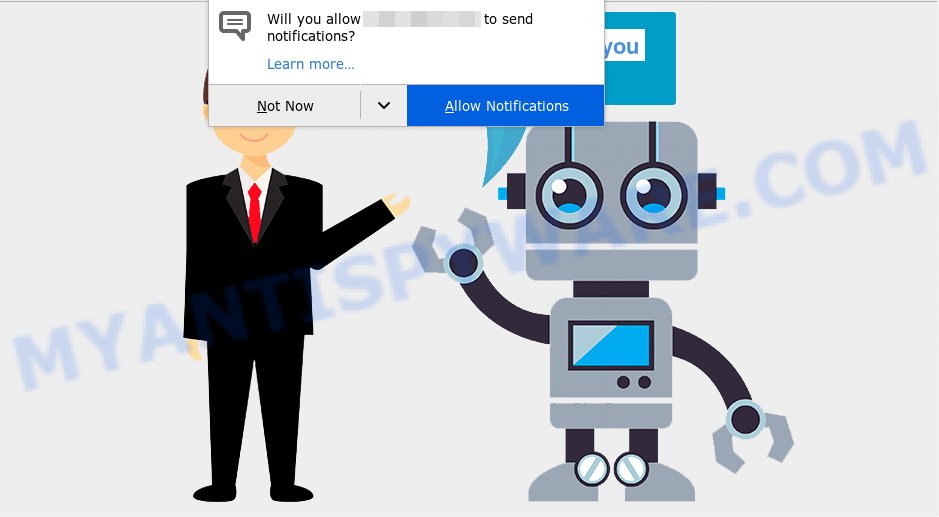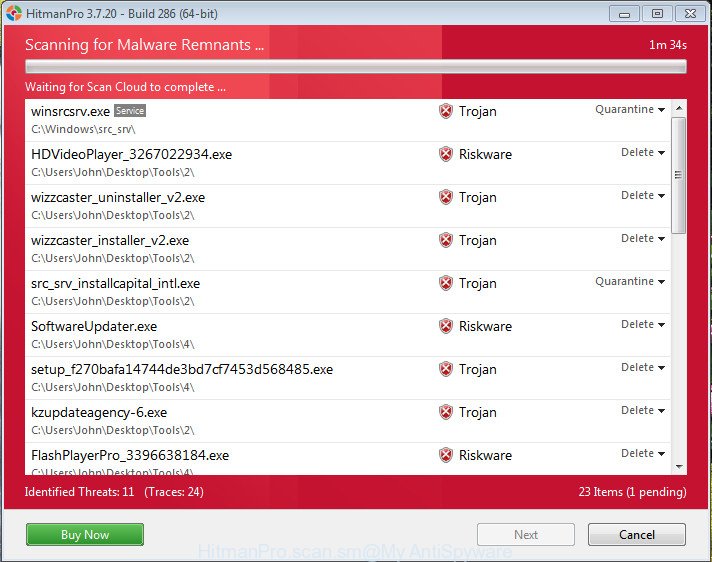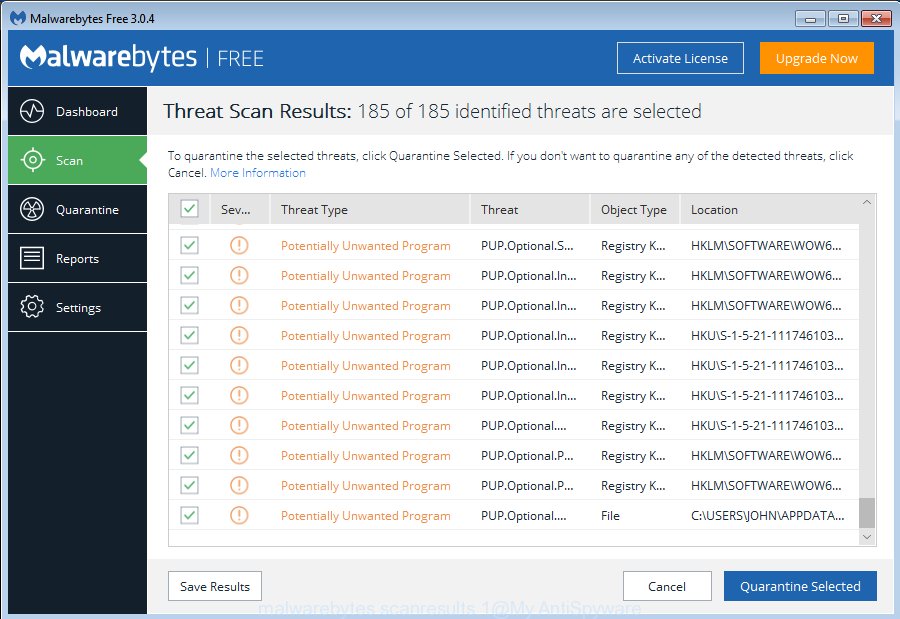Click Allow to Verify pop-ups are a social engineering attack which tries to force you and other unsuspecting users into allowing its push notifications so that it can deliver unwanted ads directly to your browser. It asks you to press on the ‘Allow’ button to access the content of the website.

“Click Allow to Verify” pop-up
If you click the ‘Allow’ button, then your web browser will be configured to display pop up adverts in the right bottom corner of your desktop. The push notifications will promote ‘free’ online games, giveaway scams, suspicious browser add-ons, adult web sites, and fake downloads like below.

If you’re getting push notifications, you can remove all spam subscriptions by going into your browser’s settings, then ‘Notifications’ settings (locate unknown and suspicious websites and remove them) or following the Click Allow to Verify removal steps below. Once you delete notifications subscription, the Click Allow to Verify pop ups ads will no longer appear on the screen.
Some research has shown that users can be redirected to the “Click Allow to Verify” scam from suspicious ads or by potentially unwanted apps and adware. Adware is an advertising malware. It is made just that: present numerous pop-ups and/or annoying ads using intrusive and at times dangerous ways. Adware software can also include other types of malicious software. It can steal confidential data from the PC and pass it on to third parties. Adware has also been the basis for hacking to gain access to the system.
The worst is, adware has the ability to gather and transmit privacy data without your knowledge. Adware be able to track information about web sites visited, internet browser and system information, and your PC system IP address.
Adware software is usually come as a part of free applications and install themselves, with or without your knowledge, on your PC system. This happens especially when you’re installing a free software. The program install package tricks you into accepting the setup of bundled apps, that you do not really want. Moreover, certain paid programs can also install optional programs which you do not want! Therefore, always download freeware and paid apps from reputable download web pages. Use ONLY custom or manual setup type and never blindly press Next button.
Threat Summary
| Name | Click Allow to Verify |
| Type | adware, potentially unwanted application (PUA), popups, pop up advertisements, pop-up virus |
| Symptoms |
|
| Removal | Click Allow to Verify removal guide |
In the step-by-step instructions below, we will explain helpful methods on how to free your PC of adware software and remove Click Allow to Verify popup from your web-browser.
How to remove Click Allow to Verify pop-ups, ads, notifications (Removal guidance)
There are a simple manual instructions below which will help you to delete Click Allow to Verify popups from your Microsoft Windows computer. The most effective way to delete this adware software is to perform the manual removal steps and then run Zemana Anti Malware, MalwareBytes Free or Hitman Pro automatic tools (all are free). The manual solution will help to weaken this adware and these malware removal utilities will completely remove Click Allow to Verify pop up and revert back the MS Edge, Internet Explorer, Chrome and Firefox settings to default.
To remove Click Allow to Verify pop ups, use the following steps:
- Remove Click Allow to Verify popups without any utilities
- How to remove Click Allow to Verify popup with free software
- Stop Click Allow to Verify pop ups
- Finish words
Remove Click Allow to Verify popups without any utilities
The steps will help you remove Click Allow to Verify pop ups. These Click Allow to Verify removal steps work for the Internet Explorer, Chrome, Mozilla Firefox and Edge, as well as every version of OS.
Uninstall PUPs using Windows Control Panel
First, you should try to identify and delete the application that causes the appearance of unwanted advertisements or web browser redirect, using the ‘Uninstall a program’ which is located in the ‘Control panel’.
Press Windows button ![]() , then click Search
, then click Search ![]() . Type “Control panel”and press Enter. If you using Windows XP or Windows 7, then press “Start” and select “Control Panel”. It will show the Windows Control Panel as shown below.
. Type “Control panel”and press Enter. If you using Windows XP or Windows 7, then press “Start” and select “Control Panel”. It will show the Windows Control Panel as shown below.

Further, click “Uninstall a program” ![]()
It will display a list of all apps installed on your system. Scroll through the all list, and uninstall any suspicious and unknown programs.
Remove Click Allow to Verify from Mozilla Firefox by resetting internet browser settings
If the Mozilla Firefox web-browser is redirected to Click Allow to Verify scam and you want to recover the Firefox settings back to their original settings, then you should follow the few simple steps below. When using the reset feature, your personal information like passwords, bookmarks, browsing history and web form auto-fill data will be saved.
First, run the Firefox. Next, click the button in the form of three horizontal stripes (![]() ). It will show the drop-down menu. Next, click the Help button (
). It will show the drop-down menu. Next, click the Help button (![]() ).
).

In the Help menu press the “Troubleshooting Information”. In the upper-right corner of the “Troubleshooting Information” page click on “Refresh Firefox” button as displayed in the following example.

Confirm your action, click the “Refresh Firefox”.
Remove Click Allow to Verify popups from Google Chrome
Reset Chrome settings can allow you solve some problems caused by adware software and get rid of Click Allow to Verify popup from web browser. This will also disable malicious add-ons as well as clear cookies and site data. When using the reset feature, your personal information such as passwords, bookmarks, browsing history and web form auto-fill data will be saved.
Open the Chrome menu by clicking on the button in the form of three horizontal dotes (![]() ). It will display the drop-down menu. Choose More Tools, then click Extensions.
). It will display the drop-down menu. Choose More Tools, then click Extensions.
Carefully browse through the list of installed add-ons. If the list has the extension labeled with “Installed by enterprise policy” or “Installed by your administrator”, then complete the following guide: Remove Chrome extensions installed by enterprise policy otherwise, just go to the step below.
Open the Google Chrome main menu again, click to “Settings” option.

Scroll down to the bottom of the page and click on the “Advanced” link. Now scroll down until the Reset settings section is visible, as shown in the figure below and click the “Reset settings to their original defaults” button.

Confirm your action, click the “Reset” button.
Remove Click Allow to Verify pop-ups from Internet Explorer
The IE reset is great if your web browser is hijacked or you have unwanted addo-ons or toolbars on your internet browser, that installed by an malicious software.
First, run the Microsoft Internet Explorer, then click ‘gear’ icon ![]() . It will display the Tools drop-down menu on the right part of the internet browser, then press the “Internet Options” like the one below.
. It will display the Tools drop-down menu on the right part of the internet browser, then press the “Internet Options” like the one below.

In the “Internet Options” screen, select the “Advanced” tab, then click the “Reset” button. The Microsoft Internet Explorer will display the “Reset Internet Explorer settings” prompt. Further, click the “Delete personal settings” check box to select it. Next, click the “Reset” button such as the one below.

When the process is complete, click “Close” button. Close the Microsoft Internet Explorer and reboot your machine for the changes to take effect. This step will help you to restore your browser’s search engine by default, newtab and home page to default state.
How to remove Click Allow to Verify popup with free software
Manual removal guidance does not always help to fully get rid of the adware, as it’s not easy to identify and delete components of adware software and all malicious files from hard disk. Therefore, it’s recommended that you use malicious software removal utility to completely delete Click Allow to Verify off your internet browser. Several free malicious software removal utilities are currently available that may be used against the adware. The optimum way would be to use Zemana, MalwareBytes Free and Hitman Pro.
Automatically get rid of Click Allow to Verify pop ups with Zemana Anti Malware
You can download and use the Zemana Anti Malware (ZAM) for free. This antimalware utility will scan all the Windows registry keys and files in your computer along with the system settings and web-browser extensions. If it finds any malicious software, adware or malicious extension that is responsible for redirections to Click Allow to Verify then the Zemana Free will remove them from your PC completely.
Download Zemana Anti Malware (ZAM) from the following link.
164799 downloads
Author: Zemana Ltd
Category: Security tools
Update: July 16, 2019
Once the download is complete, run it and follow the prompts. Once installed, the Zemana will try to update itself and when this process is complete, click the “Scan” button for checking your PC system for the adware software responsible for Click Allow to Verify pop ups.

Depending on your computer, the scan can take anywhere from a few minutes to close to an hour. Review the scan results and then click “Next” button.

The Zemana Anti Malware will start to get rid of adware software responsible for Click Allow to Verify pop-ups.
Scan your system and remove Click Allow to Verify pop-up with Hitman Pro
HitmanPro is one of the most useful tools for uninstalling adware, potentially unwanted software and other malicious software. It can scan for hidden adware in your personal computer and delete all harmful folders and files linked to adware. Hitman Pro will help you to remove Click Allow to Verify popup from your machine and Internet Explorer, Microsoft Edge, Chrome and Mozilla Firefox. We strongly recommend you to download this utility as the developers are working hard to make it better.

- Visit the page linked below to download the latest version of HitmanPro for MS Windows. Save it on your Desktop.
- After the download is finished, double click the Hitman Pro icon. Once this tool is started, press “Next” button to scan for adware responsible for Click Allow to Verify pop up. A scan can take anywhere from 10 to 30 minutes, depending on the count of files on your PC and the speed of your computer. While the utility is scanning, you can see number of objects and files has already scanned.
- When that process is complete, Hitman Pro will display a scan report. Once you’ve selected what you wish to remove from your system press “Next” button. Now click the “Activate free license” button to start the free 30 days trial to remove all malicious software found.
How to automatically get rid of Click Allow to Verify with MalwareBytes Free
If you’re having problems with Click Allow to Verify pop-ups removal, then check out MalwareBytes Free. This is a tool that can help clean up your personal computer and improve your speeds for free. Find out more below.

MalwareBytes Anti Malware can be downloaded from the following link. Save it on your Windows desktop.
327051 downloads
Author: Malwarebytes
Category: Security tools
Update: April 15, 2020
When downloading is finished, run it and follow the prompts. Once installed, the MalwareBytes Free will try to update itself and when this task is done, click the “Scan Now” button . MalwareBytes AntiMalware utility will start scanning the whole personal computer to find out adware which cause pop-ups. This task can take some time, so please be patient. While the utility is scanning, you can see how many objects and files has already scanned. Next, you need to press “Quarantine Selected” button.
The MalwareBytes Anti Malware is a free application that you can use to remove all detected folders, files, services, registry entries and so on. To learn more about this malware removal utility, we suggest you to read and follow the step-by-step guide or the video guide below.
Stop Click Allow to Verify pop ups
The AdGuard is a very good ad blocking program for the Mozilla Firefox, Edge, IE and Google Chrome, with active user support. It does a great job by removing certain types of annoying ads, popunders, pop-ups, intrusive newtab pages, and even full page ads and web site overlay layers. Of course, the AdGuard can stop the Click Allow to Verify popups automatically or by using a custom filter rule.
Download AdGuard from the following link. Save it directly to your Windows Desktop.
26840 downloads
Version: 6.4
Author: © Adguard
Category: Security tools
Update: November 15, 2018
When the download is complete, double-click the downloaded file to start it. The “Setup Wizard” window will show up on the computer screen as displayed in the figure below.

Follow the prompts. AdGuard will then be installed and an icon will be placed on your desktop. A window will show up asking you to confirm that you want to see a quick instructions like below.

Click “Skip” button to close the window and use the default settings, or press “Get Started” to see an quick guide that will allow you get to know AdGuard better.
Each time, when you launch your PC system, AdGuard will start automatically and stop undesired ads, block Click Allow to Verify pop-ups, as well as other harmful or misleading web sites. For an overview of all the features of the program, or to change its settings you can simply double-click on the AdGuard icon, that is located on your desktop.
Finish words
Now your computer should be free of the adware software that causes Click Allow to Verify pop ups in your browser. We suggest that you keep AdGuard (to help you block unwanted popups and unwanted harmful webpages) and Zemana AntiMalware (to periodically scan your personal computer for new adwares and other malicious software). Probably you are running an older version of Java or Adobe Flash Player. This can be a security risk, so download and install the latest version right now.
If you are still having problems while trying to remove Click Allow to Verify pop-up scam from the Edge, Chrome, Firefox and IE, then ask for help here here.



















